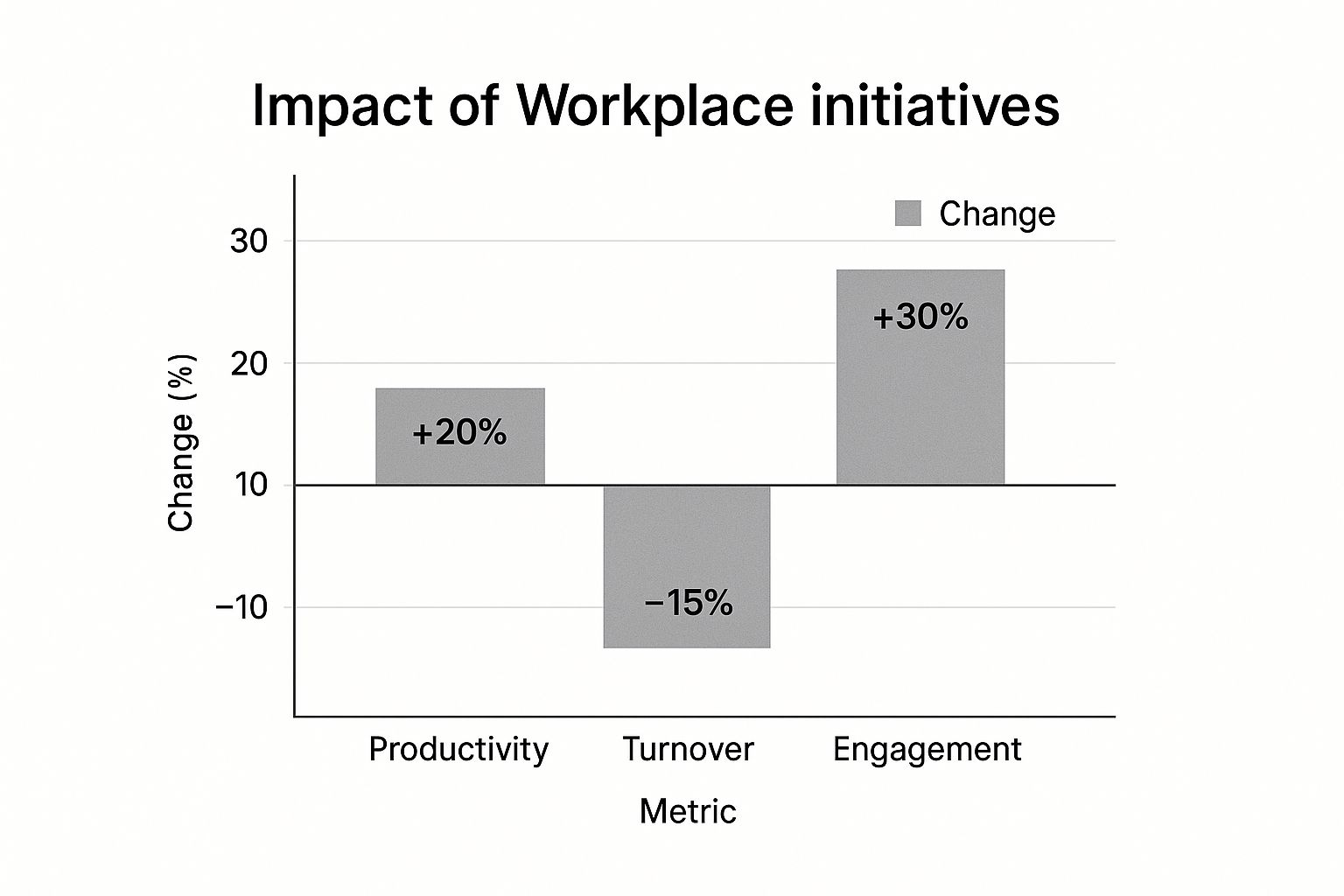How to Boost Team Morale and Inspire Your Team
Forget the pizza parties and ping-pong tables for a minute. If you really want to boost your team's morale, you have to look deeper than surface-level perks. It’s all about creating an environment built on genuine leadership, support, and authentic recognition—the stuff that makes people feel valued and connected to what they do.
What Truly Drives High Team Morale
Before you start planning the next team-building event, let's talk about what actually fuels a happy, engaged team. While fun activities are great, they often act as a temporary band-aid for more significant issues.
Real, sustainable morale is built on a solid foundation of trust, respect, and a sense of purpose. It’s a feeling that starts at the top and weaves its way through the entire company culture. When morale is high, you see it everywhere—in how people collaborate, innovate, and bounce back from challenges.
But when it's low? The warning signs are just as clear, though sometimes more subtle. You might notice people doing the bare minimum, a jump in sick days, or a general lack of energy. These aren't just bad moods; they're symptoms of bigger problems that can tank productivity and lead to your best people walking out the door.
The Manager's Critical Role
Let’s be honest: managers have the single biggest impact on an employee's daily life at work. They’re the link between the company's grand vision and the team's day-to-day reality.
The data backs this up. A recent report found that only 21% of employees are truly engaged at work. What's even more telling is that among employees who are thriving, a whopping 61% say it’s because their manager genuinely cares about them. This isn't about just being a "nice boss." It's about leading with empathy, providing clear direction, and building a space where people feel safe enough to speak up and do their best work. When a manager checks out, that disengagement spreads like wildfire.
The Tangible Business Impact
Investing in your team’s morale isn't just a fluffy, "feel-good" initiative. It directly impacts your bottom line. Happy, motivated people get more done, stick around longer, and are more invested in the company's success.
Just look at the numbers.

This isn’t just a coincidence. A positive work environment fuels better performance and retention, which is why digging into what truly drives morale is one of the most important things you can do as a leader.
To get to the heart of it, let's break down the core pillars that support a great team atmosphere.
The Core Pillars of Team Morale
A quick look at the foundational elements that directly support a positive and engaged team atmosphere.
| Pillar | Impact on Morale | Manager's Role |
|---|---|---|
| Psychological Safety | Creates an environment where people feel safe to take risks, share ideas, and admit mistakes without fear of punishment. | Foster open communication, encourage feedback, and model vulnerability. |
| Recognition & Appreciation | Makes employees feel seen and valued for their specific contributions, reinforcing positive behaviors. | Give timely, specific, and genuine praise. Create systems for both peer-to-peer and manager-led recognition. |
| Purpose & Meaning | Connects daily tasks to a larger company mission, giving work more significance beyond just a paycheck. | Clearly communicate the "why" behind projects and goals. Help individuals see how their work contributes to the bigger picture. |
| Trust & Transparency | Builds confidence in leadership and the organization, reducing anxiety and uncertainty. | Be honest, share information openly (the good and the bad), and follow through on commitments. |
These pillars aren't just abstract concepts; they are the building blocks of a resilient and motivated team.
Low morale is expensive. It quietly drains your company of its most valuable assets: creativity, productivity, and your best people. The real cost isn't in the perks you provide, but in the talent you lose when you don't.
Of course, before you start trying to fix things, you need a clear picture of where your team stands right now. A great first step is to get a baseline reading of their sentiment, which you can learn more about in our guide on how to measure employee satisfaction.
Foster a Culture of Psychological Safety

Let's be honest: great ideas often die in silence. When people are afraid to speak up, challenge a popular opinion, or admit they made a mistake, innovation grinds to a halt. The real secret to unlocking your team's potential isn't just about hiring brilliant people—it's about creating an environment where they feel safe enough to be brilliant, vulnerable, and even wrong sometimes.
That’s the heart of psychological safety.
It’s the foundation of every high-performing team I’ve ever seen. It allows people to take smart risks and voice genuine concerns without fearing they'll be shut down or punished. When psychological safety is strong, morale skyrockets because team members feel respected and heard, not just measured by their output. But this kind of environment doesn't just happen on its own; it requires a conscious, deliberate effort from you as a leader.
Lead by Example and Show Your Own Vulnerability
Your team is always watching, and they take their cues from you. If you project an aura of perfection and never admit to your own missteps, you’re unintentionally telling them that mistakes are not okay. To build real trust, you have to be the first one to be vulnerable.
Start small. Share your own challenges and what you've learned. For example, in your next team meeting, try saying something like, "I tried a new approach on the Q3 report, and frankly, it didn't quite work out. Here's what I think we can learn from it." This simple act does two incredibly powerful things: it frames mistakes as a normal part of growth and shows your team you trust them enough to be transparent.
When leaders have the courage to be vulnerable, they give their teams permission to do the same. This creates a powerful ripple effect, turning a culture of fear into a culture of learning and trust.
Set Clear Ground Rules for Healthy Debate
Conflict is going to happen. The goal isn't to avoid it but to make it productive. Some of the best ideas are forged in the fire of a healthy, respectful debate. The key is to establish some ground rules that keep discussions focused on the ideas, not the people behind them.
Before your next brainstorming or feedback session, take a few minutes to lay out some simple expectations.
- Attack the Idea, Not the Person: All feedback must be about the concept, with no personal jabs allowed.
- Assume Positive Intent: Encourage everyone to start from a place of believing their colleagues are trying to help, not tear them down.
- Listen to Understand, Not to Reply: Promote active listening, where people genuinely try to grasp a perspective before jumping in with their own.
- One Conversation at a Time: Make sure everyone gets the floor without being interrupted. It’s a simple rule that fosters massive inclusivity.
This structure helps turn what could be a tense disagreement into a constructive conversation that actually strengthens the team and leads to better work.
Open Up Dedicated Channels for Feedback
Psychological safety isn’t just built in big, formal meetings; it’s nurtured in the small, everyday interactions. By creating specific, reliable channels for feedback, you ensure everyone has a voice—not just the loudest or most confident person in the room. Regular one-on-one meetings are perfect for this, offering a private, safe space for an honest chat.
Of course, while feeling safe is a huge internal motivator, people also need to feel valued in a tangible way. Fair compensation is the other side of this coin. You can get a better handle on the financial side of employee satisfaction by checking out our guide on keeping employees happy through competitive compensation and benefits. When you pair a safe, supportive environment with fair rewards, you create an incredibly powerful combination for boosting team morale.
Make Recognition Something That Actually Means Something

Let’s be honest, feeling invisible at work is one of the quickest ways to kill someone's motivation. If you want to light a fire under your team, you have to do better than the dusty "employee of the month" plaque. It's time to build a culture of appreciation that feels real, timely, and genuine. When recognition is just a box-ticking exercise, everyone knows it.
Meaningful appreciation is a game-changer. Think about this: a staggering 53% of employees say they’re only recognized a few times a year, or even less. That gap isn't a problem; it's a golden opportunity for you to make your people feel seen for the unique value they bring to the table. The trick is to weave recognition into your daily rhythm, not save it for a quarterly meeting.
Ditch the Vague Praise—Get Specific
A generic "good job" is nice, but it evaporates a second after you say it. To make recognition stick, you need to connect it to a specific action and, most importantly, explain the impact it had. This turns a simple pat on the back into a powerful moment of reinforcement.
So instead of, "Thanks for your hard work on that project," try this: "Sarah, the way you organized all that client data into a visual dashboard was brilliant. It saved the rest of us hours of trying to make sense of it all. Your attention to detail really made a difference." See? That kind of feedback shows you're actually paying attention.
True recognition isn't just about celebrating the big finish. It's about acknowledging the grind, the creative spark, and the specific actions that got you there. It’s how you tell your team, "I see you, and what you do matters."
Let the Team Celebrate Each Other
Recognition shouldn't just be a top-down affair. I've found that some of the most potent morale boosts come from peers—the people in the trenches who see the day-to-day effort firsthand. When teammates celebrate each other, it builds an incredible sense of camaraderie.
It’s surprisingly easy to get this going. Create a dedicated channel in Slack or Microsoft Teams—call it something fun like #wins or #shoutouts. Encourage everyone to publicly thank a colleague who helped them out or did something awesome. This creates a positive feedback loop where great work is constantly being put in the spotlight by the very people who witnessed it.
High-Impact Recognition That Costs Almost Nothing
You don't need a huge budget to make people feel valued. In my experience, the simplest gestures are often the most powerful and memorable.
- A Handwritten Note: Seriously. In a world of emails and instant messages, taking five minutes to write a specific thank-you card stands out. It shows you cared enough to stop and put pen to paper.
- Celebrate the Small Wins: Don't wait for the project to be completely finished. Acknowledge the progress along the way. Did someone squash a nasty bug? Did the team hit a small milestone? Celebrate it!
- The Gift of Time: After a brutal week, offering a surprise half-day on a Friday is a powerful way to say, "I see how hard you're working, and I value your well-being."
At the end of the day, this is all about making your team feel valued. If you want to dig deeper into this, check out this great resource on the power of appreciation in keeping workers motivated and happy. When genuine recognition becomes part of your company’s DNA, you build a place where people are truly proud of their work and their team.
Champion a Healthy Work-Life Balance
Let's be real. Burnout isn’t some badge of honor; it's the ultimate morale killer. When your team is constantly running on fumes, you can watch their creativity, productivity, and passion just fizzle out.
Championing a healthy work-life balance is probably one of the most powerful things you can do to keep your team's spirits high for the long haul. This isn't just about telling people to log off at 5 PM. It's about building a culture where they can actually unplug without a shred of guilt.
Let Go of the 9-to-5 Grind with Hybrid Work
The old-school, butts-in-seats model from 9 to 5 just doesn’t cut it anymore. Giving your team flexible and hybrid options isn’t a trendy perk; it's a fundamental part of a modern workplace that people actually want to be a part of.
When you give people more say over where and when they work, you’re sending a clear message: "I trust you."
And that trust pays off. The numbers back it up, showing that 31% of fully remote employees and 23% of hybrid workers feel engaged. That's a big jump from the 19% engagement reported by folks who are stuck on-site full-time. This kind of flexibility simply helps people fit work into their lives, not the other way around, which cuts down on stress and makes them happier in their roles.
Draw a Line in the Sand to Fight "Always-On" Culture
Technology has completely blurred the line between the office and the living room. This has created a sneaky "always-on" expectation that quietly drains morale day by day. As a leader, it's your job to draw that line in the sand and fiercely protect your team's personal time.
So, how do you do it? Start by setting some clear communication ground rules.
- Kill the late-night emails. Got a brilliant idea at 9 PM? Awesome. Schedule it to send at 8 AM the next morning instead of pinging someone's phone.
- Set core collaboration hours. This is a lifesaver for hybrid teams. It defines a window when everyone can expect quick replies, leaving the rest of the day flexible.
- Actually respect offline status. If someone's Slack is set to "away" or their calendar is blocked, that time is sacred. Unless the building is on fire, it can wait.
These small, consistent habits send a huge message: you value your team as human beings, not just output machines.
Protecting your team’s personal time isn’t about lowering your standards. It’s about creating a sustainable environment where people can show up as their best, most creative selves without crashing and burning.
Lead by Example—It's the Only Way That Works
Let's be blunt: your team will never believe work-life balance is a real priority if they see you grinding away 24/7. If you're firing off emails on Sunday nights or bragging about skipping vacations, you're accidentally creating a toxic standard. Your actions will always speak louder than a paragraph in the company handbook.
Make a visible effort to log off at a decent hour. Take all of your vacation time, and I mean really disconnect. Talk about your weekend hobbies or the book you're reading.
When your team sees you taking care of yourself, it gives them the permission they need to do the same. This is such a critical, yet often overlooked, part of fixing the poor work life balance that plagues so many workplaces.
Give Your Team Room to Grow and Own Their Work

If you want to absolutely crush your team's spirit, just micromanage them and make them feel like a cog in a machine. It's a foolproof way to send your best people straight to the exit. The antidote? Giving them real ownership over their work and a clear, tangible path to grow.
When you hand over the reins and give your team genuine autonomy, you're doing more than just lightening your own load. You're sending a powerful message: "I trust you." This simple shift lets them move from just following a process to truly owning the results, often leading them to find smarter, better ways of getting things done.
Delegate to Develop, Not Just to Dump
Good delegation is a leader’s secret weapon. It’s not about offloading tasks you don’t want to do; it’s about creating opportunities for your team to build new skills, gain confidence, and see that you believe in them.
So instead of just saying, "Can you pull the numbers for the weekly report?" try reframing it. Something like, "I'd love for you to take full ownership of the weekly performance report. It's a fantastic chance to dig into our core metrics and present your findings to the team." See the difference? A routine chore just became a meaningful growth opportunity.
Micromanagement isn’t leadership; it’s a failure of trust. Real empowerment means setting a clear destination and then trusting your team to find the best way to get there.
Pave a Clear Path for Career Growth
Nothing kills motivation faster than feeling stuck in a dead-end job. People are naturally more invested when they can actually see a future for themselves at the company. This is where you, as a manager, need to step in with personalized development plans and real mentorship.
Make it a point to sit down with each person on your team and talk honestly about their career goals. What do they want to learn? Where do they hope to be in a year or two? Use that conversation to build a plan together.
- Offer Skill-Building Resources: Point them toward online courses, workshops, or industry conferences that can help them level up.
- Create Mentorship Pairings: Connect junior employees with more senior folks who can offer guidance and open doors.
- Assign Stretch Projects: Give them tasks that push them just outside their comfort zone, helping them build new skills and confidence.
Let's be real, work-related stress is a massive issue. Research from Deel shows that a staggering 77% of workers feel its effects, and for 60% of them, a lack of control over their work is a huge part of the problem. By giving your team more autonomy and a clear path forward, you’re tackling these issues head-on.
When you invest in your team’s career goals, you’re showing them you care about them as people, not just as employees. That personal commitment is the foundation for https://jimac10.tube/fostering-employee-engagement-and-value-in-the-workplace/. When people feel you've got their back, their morale—and their loyalty—will follow.
Your Questions on Boosting Team Morale, Answered
Alright, let's get into the nitty-gritty. When you start trying to put these ideas into practice, some very real questions always pop up. Here are some of the most common ones I hear from managers, along with some straightforward answers from the trenches.
How Can I Boost Morale on a Shoestring Budget?
This is the big one, right? The good news is, you don't need a fat wallet to make a huge difference. Honestly, some of the most powerful morale boosters are completely free. It’s less about fancy perks and more about how you lead.
Think about things like public recognition. A heartfelt shout-out for a job well done in a team meeting costs absolutely nothing but can make someone's entire week. The same goes for offering flexible hours when the job allows—it’s a powerful way to show you trust your team and respect their lives outside of the office.
Another great, no-cost idea is to set up a simple peer-to-peer recognition system, even just a dedicated Slack channel for "kudos." But at the end of the day, your most valuable tool is your own time. Consistently showing up for your team with genuine listening and constructive feedback in your one-on-ones? That's the best investment you can possibly make.
What's the Single Most Important Factor for Team Morale?
If I had to boil it all down to one thing, it’s this: the quality of your managers. A supportive, empathetic leader who is genuinely invested in their team's success is the absolute foundation for high morale. They create psychological safety, which is the bedrock of trust and engagement.
Without strong leadership, all the perks and team-building events in the world are just band-aids. A great manager can make a tough job feel rewarding, while a bad one can poison even a dream job.
How Do I Know If My Efforts Are Actually Working?
You need to look at both the numbers and the "vibe" to get the full picture.
On the data side, things like quick, anonymous pulse surveys are fantastic for tracking engagement scores over time. You should also keep a close eye on your employee turnover and absenteeism rates. If those numbers start trending in the right direction, you're onto something.
But don't forget to just observe.
- Are people collaborating more? Are you hearing more laughter and spontaneous chatter?
- Are more hands shooting up in meetings with new ideas?
- Do you see teammates jumping in to help each other without being asked?
These small behavioral shifts are huge indicators that you're on the right track. And of course, your one-on-ones are the perfect place to ask directly: "What's feeling better? What still needs work?"
What If Morale Is Low Because of Issues I Can't Control?
This is a tough spot to be in, and it happens all the time. Maybe it's a clunky company-wide policy or a decision from the C-suite that everyone hates. While you can't change the policy, you can change the climate on your team.
Your job is to focus on what you can influence. Double down on creating a safe, supportive bubble for your people. That means being relentless about recognizing their contributions and fiercely protecting their work-life balance.
You become their advocate and their buffer. Be transparent about the situation (without being negative), listen to their frustrations, and show them you're in their corner. That kind of loyalty and resilience is built in the trenches, and it can make a world of difference.
At JIMAC10, we believe that a supported and motivated team is the heart of any successful organization. Explore our resources to build a workplace where everyone can thrive. Discover more at JIMAC10.
Share this content:







































Post Comment